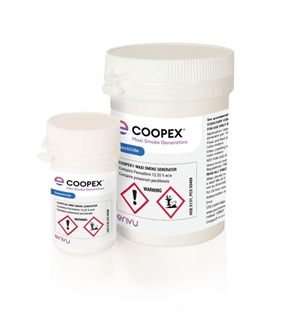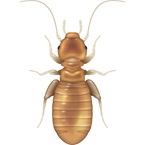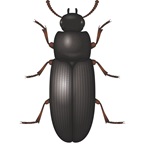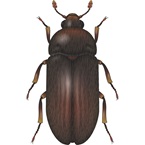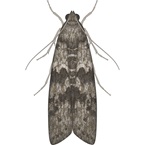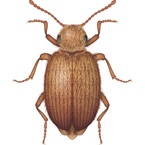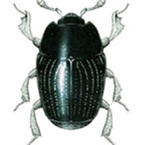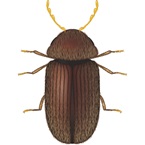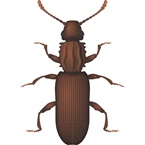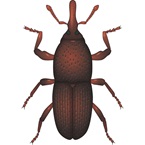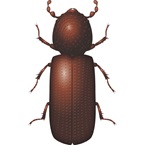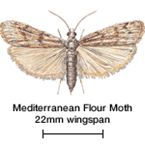Characteristics:
Forewings hard and leathery, meeting along mid-line of dorsal surface: hindwings membranous, sometimes lacking; biting mouthparts; well developed thorax; complete metamorphosis with egg, larval, pupal and adult stages.
Species characteristics:
Varied Carpet Beetle (Anthrenus verbasci)- Adults, 2-4mm long, body strongly convex
- Colour: variable, brown or black and mottled with yellow or white scales on the dorsal surface
- Ventral surface clothed with fine grey-yellow scales
- 11-segmented antennae with 3-segmented clubs at tip, clubs have nearly parallel sides
- At rest, antennae lie in recesses in thorax
- Eyes smoothly rounded
- Legs short, retracting into grooves on the ventral surface
- Larvae brown, bearing 3 bunches of golden hairs on tip of abdomen
- Adult, 2-4mm long, body strongly convex
- Colour: variable, brown or black and mottled with yellow or white scales on the dorsal surface
- Ventral surface clothed with white scales
- 11-segmented antennae with 3-segmented oval clubs at tip
- At rest, antennae lie in recesses in thorax
- Eyes indented on inner side
- Legs short, retracting into grooves on ventral surface
- Legs thickly clothed with yellow scales
- Larvae brown, bearing 3 bunches of golden hairs on tip of abdomen
Museum Beetle (Anthrenus museorum)
- Adult, 2-2.8mm long, body strongly convex
- Colour: variable, brown or black and mottled with yellow or white scales on the dorsal surface
- Antennae are 8-segmented, with 2-segmented clubs
- At rest antennae lie in recesses in thorax
- Legs short, retracting into grooves on the ventral surface
- Larvae brown, bearing 3 bunches of golden hairs on tip of abdomen
Fur Beetle (Attagenus pellio)
- Adults, oblong shape and 4.5-6mm long
- Colour: black, but for small patch of white hairs on either side of elytra
- Base of thorax also covered with white hairs
- Larvae have distinctive tuft of very long hairs which project backwards
Areas where found:
The varied carpet beetle is indigenous to Europe and in England is common south of a line drawn between Bristol and the Wash. The furniture carpet beetle is of subtropical origin and more cold sensitive. Both species are pests of animal products and occasionally food products of plant origin. Consequently, they may be found wherever these commodities are stored or handled. Carpet beetles are now one of the major pests of textiles, their success being attributed to central heating,
which ensures uniform temperatures, and to the increasing use of wall-to-wall carpeting, which allows the insects to breed undisturbed. Furthermore, the success of industrial mothproofing treatments has effectively removed the moth challenge. Warm, dry conditions are ideal for their development, but they can survive in foodstuffs of very low moisture content, e.g. 11-12%. As its common name suggests the museum beetle is commonly encountered in museums where it is a particular pest of dried specimens. It will also attack textiles and has been recorded as infesting grain. The fur beetle may be found in a wide variety of products including furs, skins, textiles and grain. Adult carpet beetles live outdoors on pollen and nectar, taken in particular from Umbelliferae and Spiraes. They can also be found wandering on walls and windows. In temperate climates the larvae are particularly evident in the autumn when they wander in search of food and hibernation sites. Carpet beetles thrive in situations where they remain undisturbed, for example beneath carpets, around skirting boards and in wardrobes. Bird and rodent nests, animal remains and dead insects are frequently reservoirs of infestations.
Larval forms can cause considerable damage to keratin-containing products such as wool, fur, leather, silk and dried animal remains. Occasionally, food products of plant origin, such as cereals and fibres, will also be attacked. Damage takes the form of clean, irregular holes and in textiles these generally occur around seams. There is no webbing or excrement present and by the time larvae are observed, considerable damage has often been done. Because of the large number of
larval moults, when cast larval skins are seen they tend to exaggerate the extent of the infestation. Carpet beetles are of limited significance as a health hazard, although they are potential vectors of anthrax. In certain situations the larval hairs cause skin irritation to those exposed to large numbers of the insects.
Lifecycle:
Varied Carpet Beetle
Mating occurs immediately after emergence. The females produce 20-100 cream-coloured eggs which are 0.5mm long, and have spine-like projections at one end. Over a period of 2 weeks these are deposited in suitable crevices, or stuck on to a potential larval feeding site by sticky secretions. In 2-4 weeks these eggs hatch to give the characteristic hairy, squat ‘woolly bears’. When mature, these are 4-5mm long, brown in colour and possess 3 bunches of golden hairs arranged in pairs on the posterior abdominal segments. The short legs are 5-segmented and well developed, with a single claw on the terminal segment. The larvae avoid light and curl up into a ball when disturbed. The length of the larval life depends upon humidity, temperature and quality of diet. Soiled commodities are usually preferred. During this time they generally moult at least 6 times, but the longer they persist the more moults occur. Pupation takes place in the last larval skin, at the site of larval development and lasts for 10-30 days. The adults live for 2-6 weeks, and are able to fly to the particular flowers on which they feed and search for egg-laying sites.
Furniture Carpet Beetle
One to three days after emergence the female lays up to 100 eggs which are produced in 1 to 3 batches. After 3 weeks the eggs hatch, to give larvae which vary in colour from white, through yellow, to chestnut brown, depending upon the colour of food consumed. Their legs are short, 5- segmented and well developed. The larvae persist for up to 12 months and are 5mm long when fully grown. The pupa develops inside the last skin. It is white in colour and lasts for 2-3 weeks, after which time the adults emerge.
Control:
The wandering habits of these insects means that they frequently infest wide areas, making them difficult to control.
Assessment of infestations
The first step in carpet beetle control is to trace the source of infestation. This may be an old nest, animal remains, wool-based lagging, soundproofing, wool-based furnishings or the debris that accumulates between and around floorboards.
a) Hygiene/management
All sources of infestation should be removed and burnt if possible. Routine surveillance and regular cleaning are also important.
b) Insecticidal control
Thorough surface spray treatments with residual activity (see recommended products) are vital where infestations are extensive in order to ensure that all larvae are killed. Care should be taken when treating carpets and other valuable furnishings.
_____________________________________________________________________________________________________
Glossary of terms:Elytra: Hardened forewings of the beetle.

